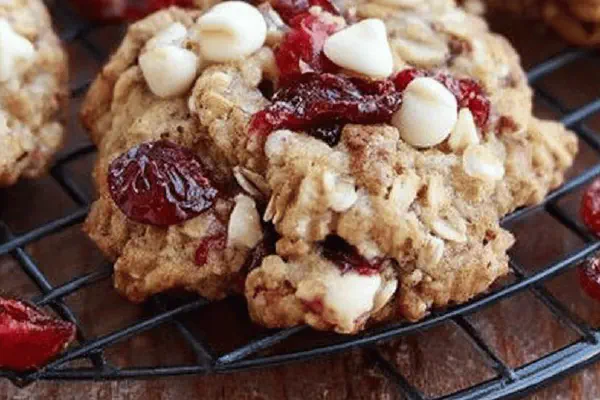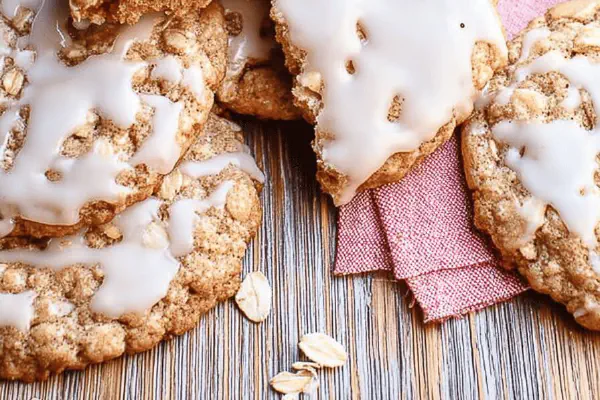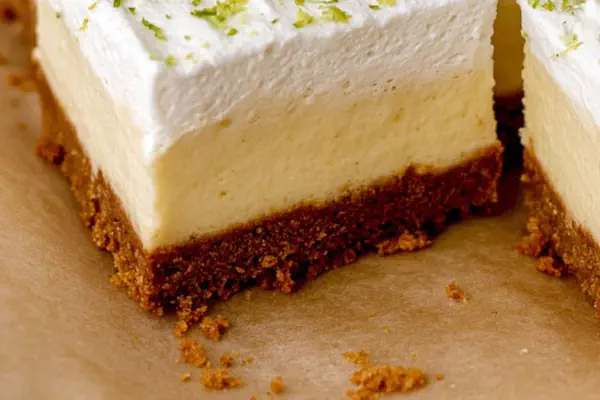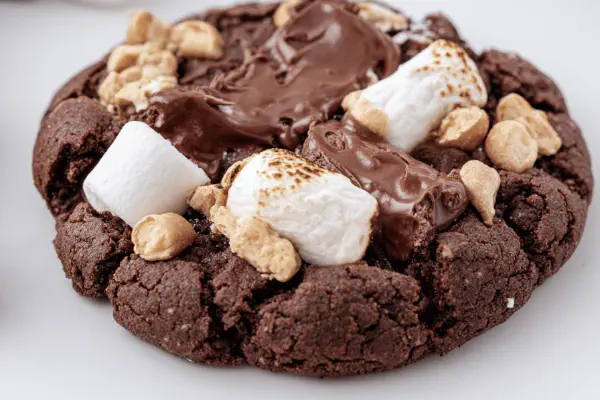Chewy Oatmeal Choc Chip
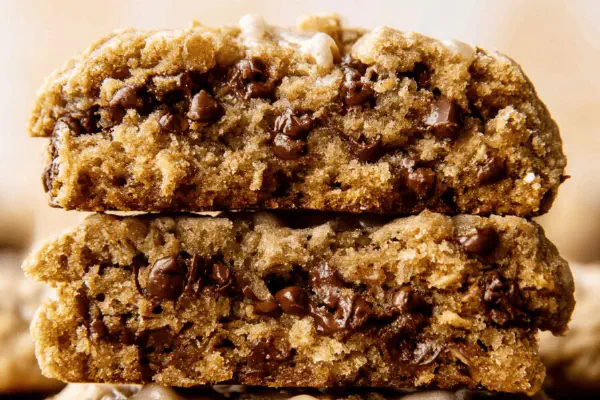
E
By Emma
Certified Culinary Professional
•
Recipe tested & approved
Oatmeal and chocolate chips mixed with a blend of flours and warm spices. Butter cold for texture, sugars creamed in stages to control moisture and browning. Molasses swapped in for depth. Bake til edges barely golden, centers soft, letting residual heat finish. Glaze drizzled afterward, adding sweet contrast. Fridge for sticky dough; freezer holds up well. Key is watching texture not timer. Flour mix includes cake and all-purpose with cornstarch for tender crumb. Cinnamon and nutmeg add warmth but can be adjusted. Perfect giant or small cookies depending on dough ball size.
Prep:
18 min
Cook:
9 min
Total:
27 min
Servings:
6 large cookies
#baking
#cookies
#oatmeal
#chocolate chips
#dessert
#homemade
Cold butter is crucial here. Creaming too long? Forget it. Makes a greasy mess. Brown sugar first, then white. Keeps moisture balanced. Molasses swapped in—not just for color but subtle tang and chew. I experimented food processor versus paddle, paddle wins every time for texture control. Powdered cornstarch cuts toughness, gives soft crumb, don’t skip. Oats hold their shape but meld nicely. Baking at 395 instead of 400 cuts overbrowning risk; every oven differs, feel the cookie edges for doneness, not stopwatch. Glaze? Not gluey but bright, with slight coffee bitter edge. Refrigerate dough if sticky; don’t rush shaping or cookies will spread wild. Learned from burnouts, this method is forgiving but watch closely.
Ingredients
- 1 ⅓ cups all-purpose flour
- ⅔ cup cake flour
- ⅔ cup rolled oats
- 1 ½ teaspoons cornstarch
- 1 teaspoon ground cinnamon
- ¼ teaspoon ground nutmeg
- ½ teaspoon baking soda
- ½ teaspoon baking powder
- ½ teaspoon salt
- ¾ cup cold unsalted butter, cubed
- ½ cup packed light brown sugar
- ⅓ cup granulated white sugar
- 1 large egg
- 1 large egg yolk
- 2 tablespoons molasses (substitute with honey for milder flavor)
- 1 ½ teaspoons vanilla extract
- 1 cup semisweet chocolate chips
- Glaze: ¾ cup powdered sugar, 2 tablespoons strong brewed coffee, 1 teaspoon vanilla extract
About the ingredients
Swapping cake for bread flour is a disaster here—too chewy, dense. Cake flour softens; cornstarch adds tenderness. Cold unsalted butter prevents spreading too fast and grease puddles. Molasses can be replaced with dark honey, but molasses lends a richer flavor and moisture. Using instant oats instead of rolled will change textures; rolled oats yield better chew. Cool dry spices fresh ground for best aroma. If out of baking powder, increase baking soda by ¼ teaspoon and add 1 teaspoon cream of tartar as substitute. For glaze, brewed coffee sharpens sweetness compared to milk or water, but those work fine. Brown sugar should be packed to keep moisture and flavor balanced. White sugar keeps crisp edges—don’t skip either. Vanilla extract indispensable; imitation doesn’t cut depth.
Method
Dry mix
- Preheat oven to 395°F. Line baking sheet with parchment or silicone mat. In a large bowl, whisk together flours, oats, cornstarch, cinnamon, nutmeg, baking soda, baking powder, salt. Set aside.
Butter and sugar
- Add cold cubed butter to stand mixer bowl fitted with paddle. Start mixer on low. Cream butter about 30 seconds until slightly softened but still cool; don’t overheat or greasy.
- Add brown sugar; mix 30 seconds to moisten sugar granules. Add white sugar gradually until combined fully. Should look fluffy but still dense.
Wet ingredients
- Crack in egg and yolk, molasses, vanilla. Mix till uniform. Scrape down sides with spatula if dough clings—important to avoid uneven texture.
Incorporate dry
- Keep mixer low. Add dry ingredients in four parts, ¼ cup at a time. Prevents flour clouds and overmixing. Stops gluten from toughening dough.
Chocolate chips
- Fold in chips with paddle on low until just distributed. Dough should be soft and slightly tacky; if sticky place in fridge 8-10 minutes. Helps shape cookies easily.
Shaping
- Portion dough into 6 large balls (about ⅓ cup each or more if you want giant). Roll lightly; do not compress. Place on sheet and gently press tops down—about ¼ inch thickness. Don’t flatten too thin or lose chew.
Bake
- Slide tray into oven. Bake for 8-10 minutes. Watch edges turn light golden while centers stay soft. Remove once edges set but centers look slightly underbaked—residual heat finishes the middle.
- Rest cookies on sheet 15 minutes off heat. This step firm ups texture without drying. Transfer with spatula to cooling rack.
Glaze
- Whisk powdered sugar, brewed coffee, vanilla until smooth. Drizzle over cooled cookies with spoon or piping bag.
- Freeze leftovers up to 3 months; thaw at room temperature for best chew.
Cooking tips
Start mixing butter cold; breaking this rule leads to greasy, thin cookies. Cream only till barely soft and fluffy, stops creaming sugars too long or butter overheats and ruins texture. Add dry ingredients gradually at low speed to avoid flour clouds and overdevelopment of gluten; dough stays tender. If dough sticks too much, chill rather than adding more flour; too much flour creates dry cookies. Shape balls moderately flattened—not too thick, not too thin—to ensure chewy centers and crisp edges. Bake shortened 30 seconds less than expected; watch edges lightly brown, centers set but still soft. Residual heat finishes bake, so removing too late means hard, dry cookies. Rest on pan 15 minutes lets cookies firm up without drying. Drizzle glaze after fully cool or else melts and loses shape. Freeze dough or baked cookies well sealed; thaw at room temperature before serving to regain chew.
Chef's notes
- 💡 Add dry ingredients slowly with mixer low speed. Prevents flour clouds. Stops gluten overdevelopment. Dough stays tender. Don’t rush. Chunks of cinnamon and nutmeg smell pop. Freshly ground better if you got them.
- 💡 Cold butter chunks. Cream short time only; stops greasy mess. Butter soft but cool, delicate balance. Starter sugar stage important; brown sugar packs moisture, then white sugar lightens texture.
- 💡 If dough sticks or feels too wet, fridge 8-10 min. Don’t add flour here, ruins chew. Cold dough easier to shape, won’t spread wild. But don’t freeze dough hard, just chill; freezer good for long term.
- 💡 Baking 395°F lowers risk of too dark edges. Watch cookies edges change color, lightly golden. Centers still soft, jiggle lightly when oven light goes off, residual heat finishes bake. Timing depends on dough ball size too.
- 💡 Glaze with coffee and powdered sugar adds brightness, sharpness. Mix till smooth but don’t water down. Drizzle after cookies fully cool—if warm, glaze melts, turns sticky. Coffee stronger than milk or water; avoids gluey finish.
Common questions
How to fix greasy cookies?
Butter too warm likely culprit. Cream shorter, butter must be cold. Don’t overbeat sugar else texture fails. Check temperature, stop creaming once soft, still cool.
Can molasses be swapped?
Yes, honey works but milder flavor. Molasses adds dark richness. Honey or dark honey closer alternative. Avoid light syrups or maple can throw off moisture.
Sticky dough what to do?
Chill in fridge first. Adds firmness, easier to handle. Avoid adding flour to fix stickiness; dries cookie. Give 10 min rest, reassess. Sometimes sticky means perfect chew.
Best storage method?
Cookies freeze well sealed. Also dough freezes but thaw fully before baking. Room temp cookies keep a couple days in airtight container. Fridge not advised long-term; dries out.
